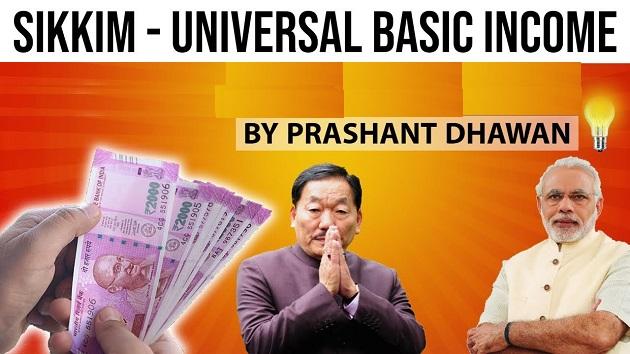Table of Contents
SO WHAT JUST HAPPENED?
- The ruling party of Sikkim, Sikkim Democratic Front (SDF) has assured the implementation of the universal basic income in Sikkim by 2022. If things go as per plan, Sikkim would become the first state in the country to implement the Universal Basic Income (UBI).
A TALKED ABOUT IDEA
- The BIEN (Basic Income Earth Network) — a network of academicians advocating for UBI to all — describes basic income as a “periodic cash payment unconditionally delivered to all on an individual basis, without means-test or work requirement.”
THE DEFINITION
- It characterises the basic income in five divisions — Periodic (being paid at regular intervals, not lump sum), cash payment (not in kind or vouchers, leaving it on the recipient to spend it as they like), individual (not to households or families), universal (for all), and unconditional (irrespective of income or prospects of job)
BIEN CONGRESS 2019 IN INDIA

BUT WHY DO WE NEED UBI ?

- BUT WHY DO WE NEED UBI ? Too many government schemes are hard to manage One basic income could help everyone
- UBI would require subsumption of other subsidies and allowances in order to free up resources.
- Subsuming other schemes is an essential prerequisite, given the sheer number of schemes and programmes run by governments in India.
- The Budget for FY18 showed there were about 950 central sector and centrally sponsored sub-schemes in the country.
- These, in fact, accounted for about 5% of GDP by Budget allocation, and top 11 schemes accounted for about 50%.
- The food subsidy or Public Distribution System (PDS) is the largest programme, followed by the urea subsidy and the MGNREGS.
- If the states are included, the number of schemes would be even larger.
THE IDEA HAS BEEN DISCUSSED EARLIER The Economic Survey of India 2016-17 A 40-page chapter, called Universal Basic Income: A Conversation With and Within the Mahatma, outlined the UBI in three components — universality, unconditionality, and agency (by providing support in the form of cash transfers to respect, not dictate, recipients’ choices).
WON’T PEOPLE BECOME LAZY WITH UBI?
- A pilot project by the Self Employed Women’s Association (SEWA) and the United Nation’s Children’s Fund (UNICEF) was implemented in Madhya Pradesh from June 2011 to November 2012, where unconditional cash transfers (UCT) were provided to the people. Citing the study, the Economic Survey 2016-17 claimed that “people become more productive when they get a basic income”.
THE SIKKIM UBI EXPERIMENT COULD HELP THE ENTIRE COUNTRY
- Sikkim is the least populated state in India, has its per capita GDP growing in double digits since 2004-05.
- Sikkim also decreased its poverty ratio by 22% to 51,000 (8.2%) in 2011-12 from 1.7 lakh (30.9%) in 2004-05. • Sikkim also became the first fully organic state.
- Sikkim’s literacy rate increased to 82.2% from 68.8% in 2001, among the country’s highest.
THE SIKKIM EXPERIMENT OF UBI
- Whether the basic income will work in a country of over 120 crore, and how is a matter for bigger discussions, but with Sikkim taking the charge, it adds another feather to the cap of the state which is ahead in several other areas- its literacy rate is 98 percent, and the state assembly, in December last year, approved the ‘one family, one job’ scheme to create over 16,000 jobs. The BPL percentage has come down from 41.43% in 1994 to 8.19% in 2011-12.
WHAT ARE THE CONCERNS IN INDIA?
- Even if two-thirds of India’s 30 crore-odd households were to be given Rs 1,000 monthly UBI, it would annually cost around Rs 2.4 lakh crore.
- There could be savings through rationalisation of subsidies and scrapping of wasteful and ineffective welfare schemes.
- However, these measures are challenging when it comes to implementation, especially in terms of price rationalisation.
























 WhatsApp
WhatsApp